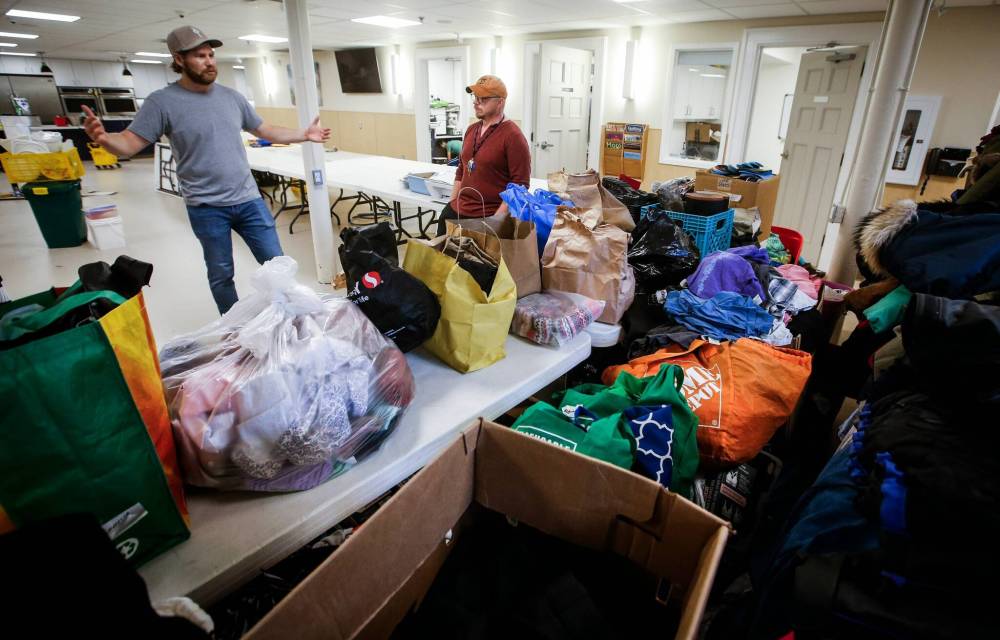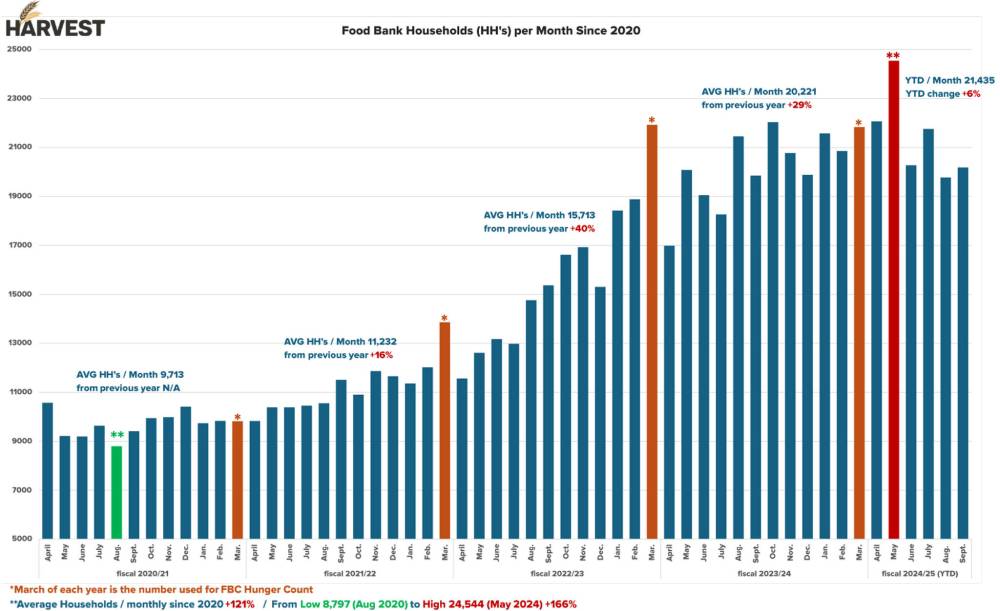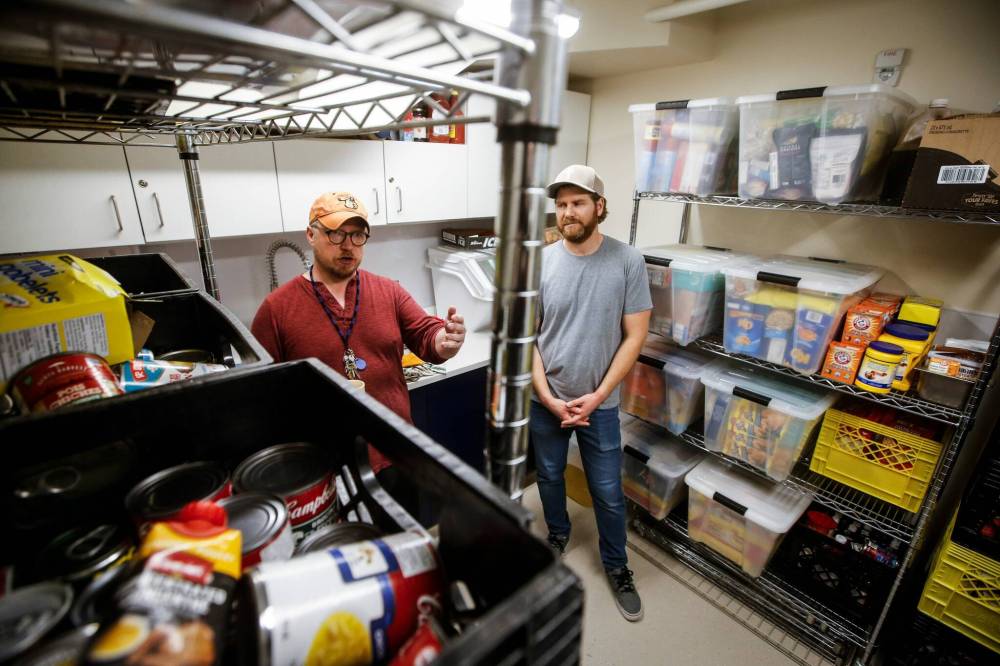’Your money doesn’t go that far’: food bank visits rise in Manitoba Organizations forced to get creative among sky-high grocery prices
Read this article for free:
or
Already have an account? Log in here »
To continue reading, please subscribe:
Monthly Digital Subscription
$0 for the first 4 weeks*
- Enjoy unlimited reading on winnipegfreepress.com
- Read the E-Edition, our digital replica newspaper
- Access News Break, our award-winning app
- Play interactive puzzles
*No charge for 4 weeks then price increases to the regular rate of $19.00 plus GST every four weeks. Offer available to new and qualified returning subscribers only. Cancel any time.
Monthly Digital Subscription
$4.75/week*
- Enjoy unlimited reading on winnipegfreepress.com
- Read the E-Edition, our digital replica newspaper
- Access News Break, our award-winning app
- Play interactive puzzles
*Billed as $19 plus GST every four weeks. Cancel any time.
To continue reading, please subscribe:
Add Free Press access to your Brandon Sun subscription for only an additional
$1 for the first 4 weeks*
*Your next subscription payment will increase by $1.00 and you will be charged $16.99 plus GST for four weeks. After four weeks, your payment will increase to $23.99 plus GST every four weeks.
Read unlimited articles for free today:
or
Already have an account? Log in here »
Hey there, time traveller!
This article was published 28/10/2024 (389 days ago), so information in it may no longer be current.
Monthly food bank use in Canada has nearly doubled since 2019, a new report has found, and Winnipeg organizations are feeling the strain.
There were more than two million visits to food banks across the country in March, up six per cent compared with last year and 90 per cent higher than in 2019, a report by Food Banks Canada shows.
In Winnipeg, some food banks have seen a near-tenfold increase.

JOHN WOODS / FREE PRESS
Michael Larson, site lead for Oak Table - 1 Just City (left), and Thomas Vanderkrogt, the organization’s food manager. Larson said rising food prices must be addressed.
Just before 11 a.m. on Monday morning, Agape Table on Furby Street had already served about 850 meals of soup, peanut butter sandwiches and yogurt.
The West Broadway food bank set a record in August, serving 1,010 meals in a four-hour period. Prior to the onset of the COVID-19 pandemic, Agape Table served between 200 and 300 meals daily.
Dwayne, who declined to give his last name, visits the food bank a few times per week. He’s been on disability since January after suffering a heart attack.
He relies on the meals towards the end of the month when his disability payment can’t be stretched any further after rent and bills.
“Whenever I get money, I go (grocery) shopping but everything is just costing so much,” he said. “Your money doesn’t go that far anymore.”
Agape Table’s general manager, Dave Feniuk, said he sees more seniors and working poor people access resources at than in years past. Immigrants, the homeless and inner-city residents make up the bulk of Agape clients, he said.
The hunger report shows low-income workers, single adults, renters, racialized and disabled Canadians use food banks the most.
HungerCount 2024, the report released Monday, noted one-third of food bank clients are children and one in five people are employed.
“People would love to have, like, meat and potatoes every day but I just can’t.”–Thomas Vanderkrogt
Harvest Manitoba CEO Vince Barletta called the report staggering, but not surprising — his organization has seen a 121 per cent increase in food bank use since 2020.
“It’s the same story all over the country: people struggling to make ends meet, struggling to cope with high prices for everything from housing to food to transportation,” Barletta said.
The national report found visits are down 3.25 per cent in Manitoba compared with March 2023. Harvest Manitoba, however, measures households served, not unique individuals.
Using Harvest’s measurements, the number of average monthly visits to food banks across Manitoba was 20,221 in the 2023-24 fiscal year — an increase of 29 per cent compared to 2022-23.
The organization has already seen more visits in the fiscal year to date — 21,435 — representing an increase of six per cent compared with the same time in the previous fiscal year.
With millions of users monthly, the food bank model is beginning to buckle under the weight of need, Barletta said. Food banks were not designed to service the current volume of clients.
“We’re going to be spending over $3 million this year to purchase food to support our work. Before 2020, that number was zero. So those things aren’t sustainable,” Barletta said. “Some food banks have already started to hit that wall.”

Source: Harvest Manitoba
At 1JustCity’s Oak Table in Osborne Village, food manager Thomas Vanderkrogt has been forced to get creative in preparing the daily meal.
Instead of meat, which is scant at the food bank these days due to its lofty price, Vanderkrogt is using more beans and lentils to supplement protein for the drop-in centre’s 160 daily guests.
“People would love to have, like, meat and potatoes every day but I just can’t,” he said. “I have to just kind of be inventive with the things that I make and how I get all the food groups in there to make sure people still have nutritious meals.”
The Food Banks Canada research study encompassed 5,100 food banks and community organizations across Canada. It listed recommendations to decrease reliance on food banks such as addressing the affordable housing crisis, helping low-income workers and addressing northern and remote food insecurity.
Oak Table site manager Michael Larson said grocery prices must also be addressed.
“I talk to people every day who are trying, but stuff so expensive,” he said. “A lot of our guests, they walk to sites all day long to get food and not have to worry about food bank as much … it’s systematic. That needs to shift.”
Statistics Canada recently reported nearly 25 per cent of Canadians will need to access food-assistance programs in the next six months.
On Monday, Progressive Conservative interim Leader Wayne Ewasko raised the issue in the Manitoba Legislature, saying food bank use is on the rise and Manitobans are struggling to make ends meet.

JOHN WOODS / FREE PRESS
Michael Larson, site lead, Oak Table - 1 Just City, right, and Thomas Vanderkrogt, food manager, Oak Table - 1 Just City. Vanderkrogt said he’s had to get creative with meals given food is more expensive.
Ewasko asked Premier Wab Kinew if the NDP government would commit to assisting food bank users.
Kinew noted the province recently signed on to the federal government’s national school food plan, which will see $17 million in federal dollars spent locally on breakfast, lunch and snack programs in schools over the next three years.
The province earmarked $30 million in this year’s budget to make healthy meals more widely available in kindergarten-to-Grade 12 schools.
nicole.buffie@freepress.mb.ca

Nicole Buffie
Multimedia producer
Nicole Buffie is a reporter for the Free Press city desk. Born and bred in Winnipeg, Nicole graduated from Red River College’s Creative Communications program in 2020 and worked as a reporter throughout Manitoba before joining the Free Press newsroom as a multimedia producer in 2023. Read more about Nicole.
Every piece of reporting Nicole produces is reviewed by an editing team before it is posted online or published in print — part of the Free Press‘s tradition, since 1872, of producing reliable independent journalism. Read more about Free Press’s history and mandate, and learn how our newsroom operates.
Our newsroom depends on a growing audience of readers to power our journalism. If you are not a paid reader, please consider becoming a subscriber.
Our newsroom depends on its audience of readers to power our journalism. Thank you for your support.
History
Updated on Monday, October 28, 2024 11:34 AM CDT: Adds graphic
Updated on Monday, October 28, 2024 6:49 PM CDT: Adds details, photos






